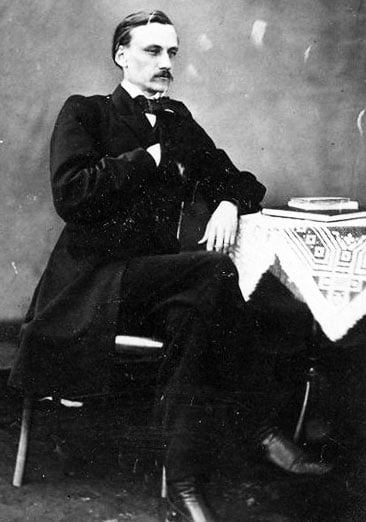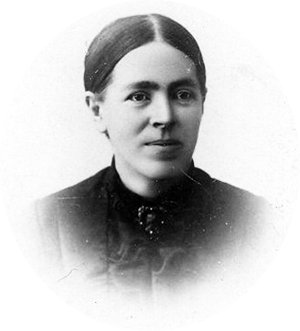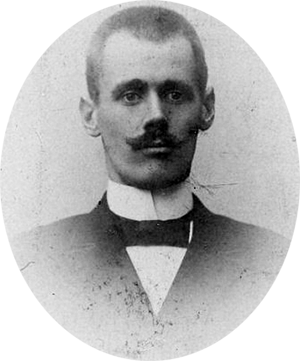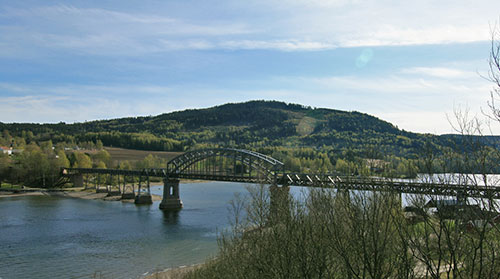
Axel Jacob Petersson
Axel Jacob (also spelled as Jakob) Petersson was born in Ålem, Kalmar County, Sweden, on 4 March 1834. He was the son of Andreas Petersson (1790-1870) and Catharina Margareta Petersson (nee Selin) (1798-1870). Axel Jacob had two brothers: Johan Alfred (1827-1870) and Karl Andreas (1830-1867), and two sisters: Kristina Sofia (1829-1891) and Amanda Charlotta (1836-1917).
In 1852 Axel Petersson enrolled at Teknologiska Instituten in Stockholm, where he studied civil engineering. He graduated in 1855 and until 1859 he worked in the Sveriges Kanalbygning (Sweden’s Channel Building organization) and in the private Jernbaneanlæg (a Swedish railway construction company). In April 1859, he was hired as an assistant engineer for the construction of the railway Kongsvingerbanen in Norway and moved with his wife Thekla Helene Haak-Petersson to Norway.
Who was Axel Jacob Petersson?
Axel Jacob Petersson—sometimes spelled “Jakob”—was a Swedish-Norwegian structural engineer and inventor. He spent his days overseeing the engineering and construction of the railways and viaducts along the Østfold Line and the Dovre Line between Eidsvoll and Hamar. He is also credited with the creation of the Krag-Petersson rifle, and a calculating machine that could purportedly complete infinite calculations.
Early life
Petersson was born in Alem, Kalmar County, Sweden 4 March 1834, the son of Andreas and Cathrine Margareta Petersson. He had two brothers, Johan Alfred and Karl Andreas, and two sisters, Kristian Sofia and Amanda Charlotta.
After moving to Sweden for school in 1852, he married Thekla Helene Haak and eventually had two daughters, Annik, who died in infancy, and Elin Margrethe, and one son, Axel Tage.
Career
Education & Early Career
Peterssen’s career began at the Teknologiska Instituten in Stockholm, Sweden, where he studied civil engineering. After graduating in 1855, he started his professional career at the Sveriges Kanalbygning, Sweden’s premier channel building organization, and Jernbaneanlæg, a Swedish railway company.
He worked at the Sveriges Kanalbygning until 1859, when he was hired as an assistant engineer for Norway’s construction of the Kongsvingerbanen railway. He and Thekla moved back to Norway together to support this career choice.
After his success with the Kongsvingerbanen railway, Petersson would eventually be appointed as the director of engineering at Norway’s Railway Construction Office.
Director of Engineering at Norway Railway Construction Office
As Director of Engineering at the Norway Railway Construction Office, Petersson would oversee the engineering of many major Norwegian railway projects. He also led the engineering and construction of several viaducts in Norway.
Petersson oversaw the construction of the railways and viaducts between Eidsvoll and Hamar, including the Ljan Viaduct, which opened following the Tay Bridge disaster in Scotland. Because Petersson died shortly before the Ljan Viaduct’s opening, a myth is that the engineer behind the Ljan Viaduct (Petersson) had committed suicide before its opening as he didn’t trust it to stand sturdy.
What is Axel Jacob Petersson known for?
Petersson is best known for his influence on the Norway railway system, but he was also a famed universal inventor. He innovated several devices and mechanisms that would become a staple of the Norwegian army.
Krag-Petersson Rifle
The Krag-Petersson Rifle is one of Petersson’s most famous inventions. It’s one of the first primary repeating rifles to enter the market and became a mainstay of the Norwegian army’s forces after its introduction.
Repeating rifles can discharge multiple rounds of ammunition between manual reloads. The Krag-Petersson model was a breech-loaded rifle that used a falling block action, meaning the breechblock which seals the breech of the gun moves downwards as the mechanism opens and is operated.
Once the mechanism had opened, an ejector would push the used cartridge out, and a fresh round of ammunition would be made into a shaped recess on the top of the breechblock. The breechblock would then rise slightly, indicating that the gun was ready to reload.
The shooter would then push the round into the chamber, and the breechblock would rise ultimately to seal the room. The increasing of the breechblock was done with a powerful spring, and if the shooter wasn’t aware of how it worked, it could result in pinched thumb skin as the breechblock would snap back into place much faster than a lot of inexperienced shooters expected.

Petersson Calculators
Petersson developed two calculators in his lifetime, but the first of them, dubbed “Calculator,” was exhibited in 1873, though it was created in 1871. This model has become very famous amongst maths enthusiasts everywhere, as it was able to calculate purportedly infinite basic arithmetic calculations.
This mechanism used a rotating drum based on the stepped drum of Leibniz, with four main components, the input mechanism, the tens-carry mechanism, the rotation counter, and the result mechanism. It allowed a user to input digits by turning dials and setting counters for each “place” in the mathematic steps (ones, tens, hundreds, etc.) and turn a key to perform basic arithmetic calculations. The revolution counter was used to perform multiplication.
Overall, the Calculator’s design is straightforward, though pretty convoluted to use compared to modern machines. But, using the time’s technology, Petersson could produce a device that could accurately calculate basic arithmetic.
It’s unknown how many Calculators were produced, but four machines have survived the times. Three are in Norwegian museums and one in the Tekniska Museet in Stockholm.
Axel Jacob Petersson: Marriage, Divorce, Children, and Personal Life
Marriage
Petersson was married to Thekla Helene Haak-Petersson. By all accounts, their marriage was a happy one. They never divorced, and the marriage only ended upon death.

Children
Petersson had three children, Annik, who died in infancy, and two surviving children, Elin Margrethe and Axel Tage.

Tragedy
Petersson tragically experienced chronic overwork, and the stress led him to poor mental health. By the 1880s, Petersson was profoundly unwell and retired in 1881 to live out his golden years. He never recovered, and he died on 15 January 1884.
Axel Jacob Peterssen: Awards and Achievements
Petersson was not granted any awards in life or death. However, his work remains a staple of structural engineering, and many of his structures are still in use today, such as the Järnvägsbron I Minnesund railway bridge

Axel Jacob Petersson Published Works and Books
Petersson was the co-author of two titles, Rules for Machine Parts Design (1866 and 1877 editions) and Rules for the Design of Waterwheels and Turbines (1868 edition.) He was also an author of a series of railway construction articles published in the scientific journal Polyteknisk Tidsskrift.
- Rules of Machine Parts Design (1866 Edition)
- Rules of Machine Parts Design (1877 Edition)
- Rules for the Design of Waterwheels and Turbines (1868 Edition)
- Polteknisk tidsskrift (Various Articles Published Therein)